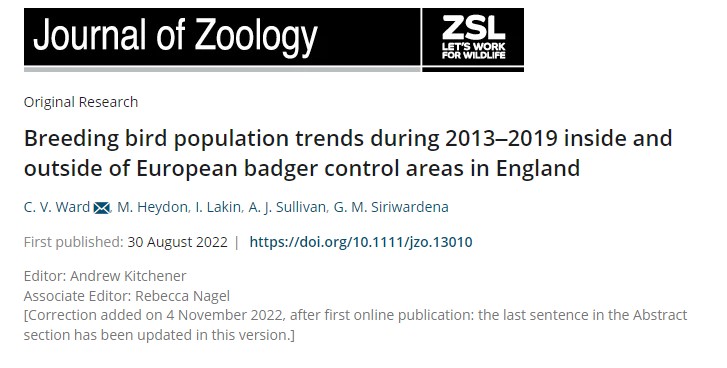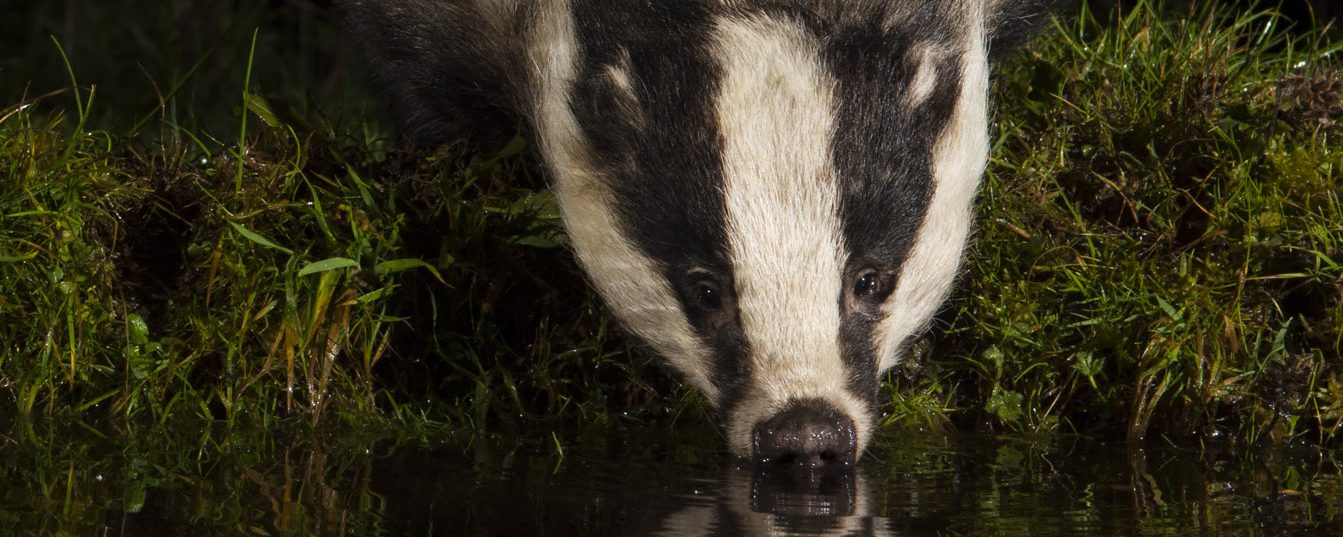
The Abstract of a paper on the potential harmful impacts of badger culling on other species and habitats in the Journal of Zoology (1) this year has been amended to better reflect the contents of the paper.
The original Abstract of the paper, whose authors include two Natural England employees working alongside researchers from the British Trust for Ornithology on licensing the culling of badgers, contained a sentence saying that badger removal ‘..has not affected bird populations..’. However, the important main conclusion from the work, and one better supported by the findings of the analyses, was rather different – that ‘A landscape scale, quasi-experimental approach is strongly recommended to provide stronger inference about the complex potential ecological effects of culling predators such as the badger.’
The changes reflect and highlight the paucity of effort that government has taken to investigate ecological impacts since mass badger culling began in 2013. Defra and Natural England escaped full judicial scrutiny earlier this year by a ‘smoke and mirrors’ approach to remaking an impugned decision to disregard side-effects on wildlife outside designated sites. Behind the backs of the claimant, and of the court (see here) they made just enough of a procedural correction to satisfy the judiciary. They kept their ’do nothing’ approach alive, at least until new powers arrive under the new Environment Act once that is enacted.
In recent weeks, Natural England have been approached via lawyers to address the issue of the ‘strong recommendation’ in the August 2022 paper. They have been asked how they have responded to the published finding that a different, larger scale approach is needed before the potential damage from badger culling can be properly assessed, when granting licences to mass-kill badgers over the wider countryside. Government’s entrenched position in 2021 was that ecological studies were too expensive, and it was ‘too late’ for meaningful research as badger culling is being phased out by 2025.
Such impacts are important when considering the fate of European Protected Species and those priority species and habitats afforded protection under the 2006 NERC Act. There are legal duties to fulfil.
Dominic Woodfield has provided expert advice and witness statements relating to challenges to Natural England’s defective approach to protecting nature in England when organising badger culling over the last five years, including High Court rulings where judges found that NE had been in breach of its statutory duty by neglecting nature conservation protection. He said:
“The abstract of a paper is the most public-facing element and often the only bit that gets read by busy people looking to gain a rapid insight into current science and issues. It is therefore very important that it is an accurate summary of the conclusions reached.
We don’t know whether the original authors or the Journal editors were responsible for the error of representation in the abstract in this case, but it is evident that the publisher now accepts and agrees that it was misleading and that it did not reflect the actual results and conclusions of the study. Perhaps incidentally, or perhaps not, it had the further effect of masking the inadequacy of the effort made by Natural England to investigate insidious but potentially significant side-effects on sensitive bird species arising from the Government’s badger culling policy – side-effects that remain a mystery after an unknown amount of money wasted on meaningless desk-top analyses.
The study actually, and inevitably, concludes with a statement that vindicates mine and others’ view that the approach being reported on is a waste of public money and tantamount to kicking the can down the road for fear of getting an unwanted answer. As a body no longer even semi-autonomous from Government, one might expect Natural England to want to ‘spin’ the presentation of the results, but if that is indeed what happened here, it would be a matter of much more concern that the BTO would seem to have been complicit in such actions.“
The correction to the abstract of the paper is shown below.
Abstract
Since 2013, the Department for Environment, Food and Rural Affairs (Defra) has licenced culling of European badger (Meles meles) populations in several English regions. In the first 7 years, more than 100 000 badgers have been removed. It is critical to evaluate the ecological impact of severely depressing the population of a widespread predator from large areas of the country, such as effects on breeding bird populations. Citizen science survey data on the abundance of breeding birds supports the estimation of population trends, i.e. whether species are exhibiting population growth or declines, and the effects of potential environmental influences, such as badger removal, on these trends. Here, these survey data are used together with data on the presence and amount of culling in an area to explore whether removing badgers has an effect on breeding bird populations both inside and outside culling zones from 2013–2019. This is not equivalent to a controlled trial, but collects critical, landscape-scale evidence in real-world conditions. In analyses evaluating the effect of culling presence, 18 of 55 bird species showed significant or near-significant growth rate changes. Of these, four species had higher growth rates and 14 exhibited lower growth rates in cull areas, compared to areas outside of the culling zones. When using culling intensity data to assess the impact on growth rates, 10 of 55 species showed significant or near-significant results, with only one species exhibiting a higher population growth rate in the presence of more intensive culling. Predicted sensitivity to badger effects based on species’ ecologies did not predict whether the measured relationships were significant, or their directions, suggesting that other factors underlie the patterns seen. Hence, there was little evidence to indicate consistent, community-level effects of badger removal on bird populations. Reasons why this predator removal has not affected bird populations are discussed. A landscape scale, quasi-experimental approach is strongly recommended to provide stronger inference about the complex potential ecological effects of culling predators such as the badger.
This correction was added to the Journal paper on 4th November 2022.

